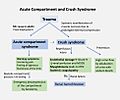Crush syndrome facts for kids
Crush syndrome is a serious medical problem. It happens when a person's muscles are squeezed or squashed very hard for a long time. This can cause a type of body shock and stop the kidneys from working properly. Crush syndrome can be very dangerous and even lead to death if not treated quickly.
Contents
What Causes Crush Syndrome?
Crush syndrome often happens after big accidents or disasters. Imagine if a building falls down, or if someone gets trapped under heavy objects.
- Earthquakes: Many people get crush syndrome after earthquakes. They might be trapped under fallen buildings.
- Accidents: Car crashes, industrial accidents, or even being pinned by heavy machinery can cause it.
- War or Conflict: Explosions or collapsing structures during war can also lead to crush injuries.
- Being Trapped: Any situation where a large part of the body, especially a limb, is pressed for hours can cause this syndrome.
The longer a person is trapped, the more serious the crush injury can become.
How Does Crush Syndrome Affect the Body?
When muscles are crushed, their cells get damaged. These damaged muscle cells release harmful substances into the bloodstream.
- Harmful Substances: One main substance released is called myoglobin. It's a protein normally found in muscles.
- Kidney Damage: When myoglobin travels to the kidneys, it can block them up. This stops the kidneys from cleaning the blood properly.
- Fluid Shift: A lot of fluid can leak into the injured area, causing swelling. This means less fluid is available for the rest of the body.
- Shock: The body can go into shock because of fluid loss and the harmful substances. Shock means the body isn't getting enough blood flow to its important organs.
- High Potassium: Another dangerous substance released is potassium. Too much potassium in the blood can make the heart beat irregularly, which is very risky.
All these changes can happen quickly once the crushing pressure is removed.
What Are the Symptoms?
The symptoms of crush syndrome can appear right after the person is freed from what was crushing them.
- Pain and Swelling: The crushed body part will be very painful and swollen. It might look bruised or discolored.
- Weakness: The person might feel very weak or unable to move the injured limb.
- Dark Urine: One key sign is dark, reddish-brown urine. This is because of the myoglobin from the damaged muscles.
- Feeling Sick: They might feel nauseous, vomit, or feel confused.
- Low Blood Pressure: The body can go into shock, leading to very low blood pressure.
- Irregular Heartbeat: High potassium levels can cause the heart to beat strangely or dangerously.
It's important to get medical help right away if someone shows these signs after a crush injury.
How Is Crush Syndrome Treated?
Treating crush syndrome needs quick action from doctors and nurses.
- Fluids: Doctors give a lot of intravenous (IV) fluids. This helps to flush out the harmful substances from the kidneys.
- Monitoring: Patients are closely watched. Doctors check their blood pressure, heart rate, and kidney function.
- Medication: Medicines might be given to help balance the chemicals in the blood, like potassium.
- Dialysis: If the kidneys stop working completely, a machine called a dialysis machine can clean the blood. This machine does the job of the kidneys.
- Surgery: Sometimes, surgery is needed to relieve pressure in the swollen limb. This is called a fasciotomy. It helps prevent further muscle damage.
Early treatment is very important to prevent serious problems and save lives.
Images for kids
See also
 In Spanish: Síndrome de aplastamiento para niños
In Spanish: Síndrome de aplastamiento para niños


